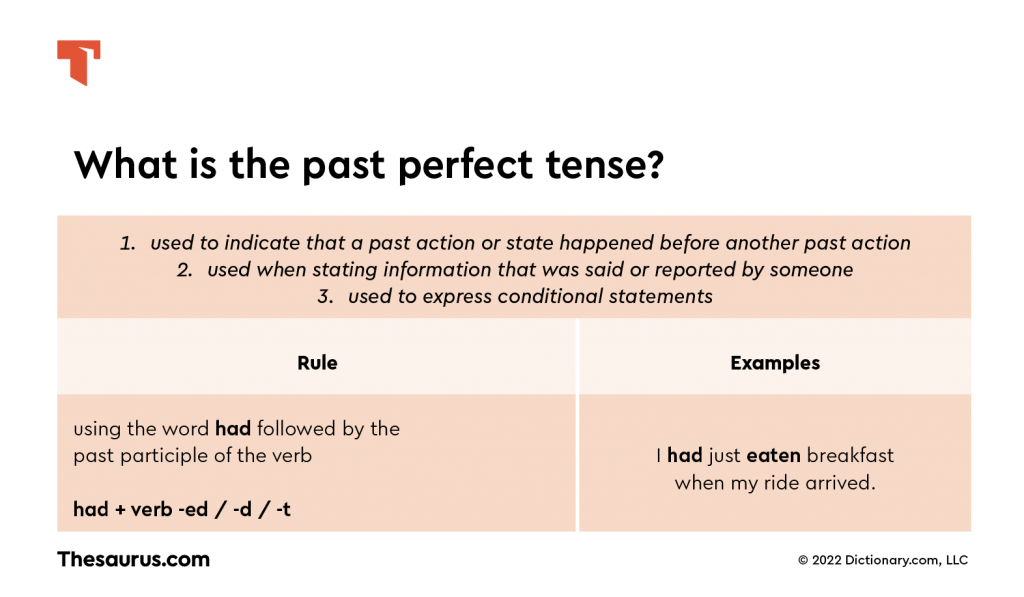An amazing thing happened the other day. A man had finished his jog around the block when he saw a tiger stroll down the sidewalk. A woman nearby told him that the tiger had escaped from the circus. Before an influencer could take a selfie with the tiger, a troupe of clowns had chased it down the street. On the news later that night, a newscaster said that the tiger’s handler had caught him before anyone got hurt. What do you think of this little story? It was pretty interesting, but did you also catch that used a neat bit of grammar called the past perfect tense?
What is past perfect tense?
When we want to express actions or states of being we use words called verbs. When it comes to English verbs, we use many different verb tenses in our sentences. The tense of the verb, generally speaking, tells you when in time an action or state happens. In the case of past perfect tense, it tells us that an event happened in the past before another event in the past. For example, the sentence Daniel had left by the time Erica got to his house uses the past perfect tense to say that Daniel left his house before Erica arrived. Both of these actions happened in the past, but one of them happened before the other.
If we break apart the name of this verb tense, we can see it is telling us how to use it:
- Past: The verb tense refers to an action or state that occurred before now.
- Perfect: Generally speaking, perfect verb tenses refer to completed states/actions. In the case of past perfect tense, we often refer to an action/state that was totally completed before another one.
There’s a lot more to say about the simple past tense than you might think. Read more about it here.
When do you use perfect past tense?
One of the main reasons that we use the past perfect tense, also called the pluperfect tense, is to indicate that a past action or state happened before another past action or state. You can see examples of this in the following sentences:
- I had caught ten fish before my dad caught one.
- When we found our dog, he had gotten stuck in a fence.
- She didn’t eat any of the stew because she had already eaten a big lunch.
All of these sentences use different constructions, but in all three the clause that uses the past perfect tense describes an action that happened earlier in time than the clause that uses the simple past tense.
Sometimes, the event that an action or state is being compared to isn’t always explicitly stated. For example:
- With a quick glance, I could tell that the teenagers had visited the store.
In this sentence, the action described with the past perfect tense isn’t being compared to another past action that is specifically mentioned in the sentence. However, the context of the sentence implies that the teenagers visited the store before I did or before I arrived at the store.
Another common reason that we use the past perfect tense is when stating information that was said or reported by someone. The following sentences give examples of the past perfect tense used this way:
- Nick told me that Marta had visited him this morning.
- She said I had taken a wrong turn.
- They claimed the cat had broken the vase.
The “someone” can even be yourself as in I thought I had fed the hamsters already, but I guess I was wrong.
We also often use the past perfect tense to express conditional statements. These sentences typically use the word if. For example:
- If I had studied harder, I’d have passed this test.
- If my dad had asked for directions, we wouldn’t have gotten lost.
- We could have avoided this mess if you had just told the truth.
How to form past perfect tense
The past perfect tense is formed by using the word had followed by the past participle of the verb. For regular verbs, the past participle is a form of the verb that ends in -ed or -d. For example, the past participle of watch is watched. Some verbs also use a –t variant, where the past participle ends with -t instead of -ed. For example, the past participle of learn is learnt and the past participle of leap is leapt.
However, there are many irregular verbs whose past participles do not follow this rule. For these verbs, there are no general rules regarding their past participles and you will simply need to learn them or look them up in our amazing dictionary. Here are some examples of irregular verbs:
- be → been
- eat → eaten
- wake → woken
- saw → seen
- catch → caught
- do → done
- think → thought
Here are examples of sentences using the past perfect tense with regular and irregular verbs:
- I had just finished my breakfast when Zach knocked on the door.
- When the detective arrived, the police had already built a perimeter around the crime scene.
- She swore that a creepy statue had been in the hallway just a moment ago.
We can shorten our sentences using contractions:
- He’d started a new painting when I entered the studio.
- Before we could even ask, they’d already gotten us refills.
How to make past perfect tense negative
In order to make past perfect tense negative, we just put the word not after the word had. The contraction hadn’t can also be used. Here are examples of the past perfect tense used in the negative:
- He told me he had not ever been to Italy before.
- He told me he hadn’t ever been to Italy before.
- She scowled at me and I hadn’t even said anything.
- She scowled at me and I had not even said anything.
- The mall hadn’t been open five minutes before it was packed with Christmas shoppers.
- The mall had not been open five minutes before it was packed with Christmas shoppers.
- I don’t think my parents believed us when we said we had not shaved the dog.
- I don’t think my parents believed us when we said we hadn’t shaved the dog.
All the verbs, none of the errors
Confused about verb tenses? Not sure if you’re using the past, past perfect, or past continuous tenses correctly? Check your writing on Thesaurus.com’s Grammar Coach™. This writing tool uses machine learning technology uniquely designed to catch grammar and spelling errors. Its Synonym Swap will find the best nouns, adjectives, and more to help say what you really mean, guiding you toward clearer, stronger, writing.
Whether you’re writing in the past, present, or future, perfect grammar has never been easier.















